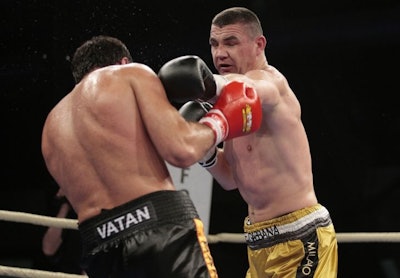 Photo via World Series Boxing/Flickr.
Photo via World Series Boxing/Flickr.
There have been numerous preliminary bouts with the Eme going back to the 1970s. The original Los Angeles Prison Gang Task Force cases are well documented in books such as "The Mexican Mafia: The Story" by task force member Robert "Moco" Morrill, "Mexican Mafia: The Gang of Gangs" by Eme member Ramon "Mundo" Mendoza, and "La Familia: The Family, Prison Gangs in America" by gang cop Gabriel Morales.
My experience in the "ring" (court cases) with the Mexican Mafia included federal RICO cases in 1995, 1997, and 1999. Independent of these federal cases, they included numerous capital murder and conspiracy cases in state courts and before the grand jury. You can read about some of these in books like "The Mexican Mafia" by Tony Rafael and "The Black Hand" by Chris Blatchford.
Every time law enforcement thought that they had knocked out or retired the Eme organization, they found that the Eme came back again. The Mexican Mafia absorbed the blows and grew stronger. There's a term boxers use to describe this resilience and tenacity; they call such an opponent "scrap iron." You can wear yourself out by pounding on this pile of scrap iron.
In a more recent match in 2008, a DEA task force of federal and local San Bernardino agencies targeted Mexican Mafia members and associates infiltrating the San Manuel Band of Mission Indians and their casino in Highland, Calif. When members of the tribe conspired with Mexican Mafia member Salvador "Toro" Hernandez and his brother Alfred Hernandez to kill nightclub manager Leonard Epps, the DEA task force intervened and faked Epps' death. In December, they executed 43 search warrants, made 19 arrests and seized 56 guns and over $1 million in methamphetamine.
The Hernandez brothers and tribe members Stacy and Erik Barajas pled guilty to the conspiracy to commit murder and made gang admissions as well. This blow was followed by an unexpected one. The intended victim Leonard Epps filed a suit against the conspirators.
The San Bernardino Sun ran the headline, "San Bernardino man marked for death by San Manuel tribal members to get $4.5 million." The article goes on to say that the second phase of the trial will begin Aug. 26, when jurors will deliberate on how much more to award Epps in punitive damages.
Not only has the Eme suffered law enforcement exposure and arrest of their big homies and members of their Sureno army, but the resulting law enforcement financial probe into their corrupting influence is threatening their newfound cash cow of Native-American gaming. To their surprise, the intended murder victim used the law to fight back. I don't think there's ever before been an Eme "green lighted" individual who had the nerve to sue them. An award of several million dollars can buy the threatened party a lot of security. It also opens up the members of the criminal organization financially. This blow hits them where it hurts worse—in the wallet.
The Los Angeles Times ran the headline, "Feds indict dozens in alleged Mexican Mafia, drug cartel scheme." The article documents a major blow to the Eme by a Los Angeles ATF task force in cooperation with California law enforcement across the state. The take-down targeted dozens of street gang members, including 13 members linked to the Mexican Mafia and associated La Familia Cartel members.
The seven count federal indictment outlines "The Project," a venture by the Mexican Mafia utilizing loyal street gang members to provide La Familia members "free rein" to distribute methamphetamine and to provide the La Familia members with protection in and out of jail and prison custody. Many of the street gang members were hardcore members of the Florence 13 gang from South Central Los Angeles. More than 600 pounds of methamphetamine were seized during the investigation.
Some of the arrests occurred in San Bernardino County but the arrests reached up as far as Fresno where Mexican Mafia veterans Michael "Boo Boo" Moreno and Jimmy "Rube" Soto were arrested in residences in Visalia. Lt. Mark Salazar, chief of the Fresno Police Department's Street Violence Bureau, told the Fresno Bee that the Mexican Mafia has increased its presence in Fresno in recent months. In 2013, there were 17 Sureño gang shootings in the city compared with 10 last year. Salazar called the Sureños the Mexican Mafia's "minor league."
Former Mexican Mafia member "Mundo" Mendoza commented to me on this Mexican drug alliance. "The Eme's relationship with Mexican drug families is almost as old as the Eme itself," he said. "Beginning in 1969, Eme member Alejandro "Hondo" Lechuga established a pipeline from his hideout in Juarez, Mexico, to the Hawaiian Gardens section of Los Angeles. Jesus "Chuy" Araujo was another major Mexican drug lord who worked with us in the mid-1970s, and his family was taken down by DEA. In varying degrees since then, we have seen the Eme work with the Felix-Arellano Cartel and pretty much whichever cartel is good for Eme business."
Mundo offered the following advice to law enforcement "My current advice (which is echoed by Rene "Boxer" Enriquez in "The Mexican Mafia Encyclopedia") is for the Bureau of Prisons (and any state facilities where Eme and cartel members are housed) to separate these two groups before solid relationships can be established and nurtured. Mexican cartels would also be wise to shun too close a relationship with Eme because the Mexican Mafia would ultimately seek to control it all."
My advice to law enforcement is that it needs to press the attack on the Mexican Mafia while the organization is still stunned and against the ropes. There is also a need to tag-team with Mexican law enforcement and Interpol to share intelligence and coordinate our blows against the growing alliances. Just because the Mexican Mafia may have taken a good combination or two and maybe a fall, don't count them out.
















